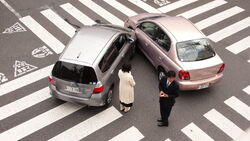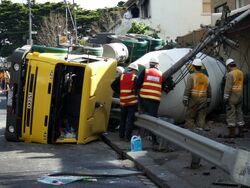(→Backup collisions: -L) |
|||
| Line 24: | Line 24: | ||
==Backup collisions== |
==Backup collisions== |
||
| − | Backup collisions happen when a driver reverses their car into an object, person, or another car. Although most cars come equipped with |
+ | Backup collisions happen when a driver reverses their car into an object, person, or another car. Although most cars come equipped with rear view mirrors, which are adequate for detecting vehicles behind a car, they are inadequate on many vehicles for detecting small children or objects close to the ground, which fall in the car's blind spot. Large trucks have much larger blind spots that can hide entire vehicles and large adults. |
| − | According to research by |
+ | According to research by Kids and Cars – an organization devoted to preventing (non-traffic) motor-vehicle-related deaths and injuries – 49% of the non-traffic, non-crash fatalities involving children under 15 from 2001–2005 were caused by vehicles backing up. |
The CDC reported that from 2001–2003, an estimated 7,475 children (2,492 per year) under the age of 15 were treated for automobile back-over incidents. |
The CDC reported that from 2001–2003, an estimated 7,475 children (2,492 per year) under the age of 15 were treated for automobile back-over incidents. |
||
Revision as of 12:44, 17 July 2010
Assessment |
Biopsychology |
Comparative |
Cognitive |
Developmental |
Language |
Individual differences |
Personality |
Philosophy |
Social |
Methods |
Statistics |
Clinical |
Educational |
Industrial |
Professional items |
World psychology |
Other fields of psychology: AI · Computer · Consulting · Consumer · Engineering · Environmental · Forensic · Military · Sport · Transpersonal · Index

Minor collisions such as this one are the most common type of crash.
A car accident or car crash is an incident in which an automobile collides with anything that causes damage to the automobile, including other automobiles, telephone poles, buildings or trees, or in which the driver loses control of the vehicle and damages it in some other way, such as driving into a ditch or rolling over. Sometimes a car accident may also refer to an automobile striking a human or animal. Car crashes — also called road traffic accidents (RTAs), traffic collisions, auto accidents, road accidents, personal injury collisions, motor vehicle accidents (MVAs), — kill an estimated 1.2 million people worldwide each year, and injure about forty times this number (WHO, 2004). In the UK the Department of Transport publish road deaths in each type of vehicle. These statistics are available as "Risk of injury measured by percentage of drivers injured in a two car injury accident." These statistics show a ten to one ratio of in-vehicle accident deaths between the least safe and most safe models of car.
The statistics show[How to reference and link to summary or text] that for popular, lightly built cars, occupants have a 6–8% chance of death in a two-car accident. (e.g. BMW 3 series 6%, Subaru Impreza 8%, Honda Accord 6%). Traditional "safety cars" such as the Volvos halve that chance (Volvo 700 4% incidence of death, Volvo 900 3%).
Motorcyclist deaths within England and Wales stand at 53% of the annual road death statistics. Scooters/mopeds up to 50cc only account for 3% of those deaths. 2% of the scooter deaths were 16–19 year olds who had not taken CBT (Compulsory Basic Training). (Statistics taken from 2004/2005 DSA annual road deaths percentages)
Trends in collision statistics

In an accident resulting from excessive speed, this concrete truck rolled over into the front garden of a house. There were no injuries, but significant damage was caused.
Road toll figures show that car collision fatalities have declined since 1980, with most countries showing a reduction of roughly 50%. This drop appears to confirm the efficacy of safety measures introduced thereafter, assuming that driver behaviour has not changed significantly.
In the United States, fatalities have increased slightly from 40,716 in 1994 to 42,884 in 2003. However, in terms of fatalities per 100 million miles driven, the fatality rate has dropped 16% between 1995 and 2005. Injuries dropped 37% over the same period. (National Traffic Safety Administration, 2006)
It has been noted that road fatality trends closely follow the so-called "Smeed's law" (after RJ Smeed, its author), an empirical rule relating injury rates to the two-thirds power of car ownership levels. An analysis by John Adams can be found here.
Backup collisions
Backup collisions happen when a driver reverses their car into an object, person, or another car. Although most cars come equipped with rear view mirrors, which are adequate for detecting vehicles behind a car, they are inadequate on many vehicles for detecting small children or objects close to the ground, which fall in the car's blind spot. Large trucks have much larger blind spots that can hide entire vehicles and large adults.
According to research by Kids and Cars – an organization devoted to preventing (non-traffic) motor-vehicle-related deaths and injuries – 49% of the non-traffic, non-crash fatalities involving children under 15 from 2001–2005 were caused by vehicles backing up.
The CDC reported that from 2001–2003, an estimated 7,475 children (2,492 per year) under the age of 15 were treated for automobile back-over incidents.
In its “Deaths and Injuries Resulting from Certain Non-Traffic and Non-Crash Events,” report issued in May of 2004, the National Highway Traffic Safety Administration found that back-up collisions most often:
- Occur in residential driveways and parking lots
- Involve sport utility vehicles (SUVs) or small trucks
- Occur when a parent, relative or someone known to the family is driving
- Particularly affect children less than five years old
The driver of the car backing up and hitting an object, a person, or another car is usually considered to be at fault.
Prevention organizations suggest that parents use common sense, and also take safety measures such as installing cross view mirrors, audible collision detectors, rear view video camera and/or some type of reverse backup sensors
Collision prevention
Although many crashes are caused by [[[driver behavior]] that is difficult to alter, by mechanical failure, or by road conditions, some technical solutions would automatically detect how close the driver is to the car in front and automatically adjust the car's acceleration to prevent the car from getting closer than the distance in which it can safely stop.
- Sobriety detectors: These locks prevent the ignition key from working if the driver breathes into one and is shown to have consumed alcohol.
- Drifting monitors: These devices monitor how close a vehicle is traveling to lane markers and, if it starts to drift toward or over the markers without the turn signal being activated, sounds an alarm.
See also
- Defensive driving
- Driving behavior
- Highway safety
- List of countries by traffic-related death rate
- Pedestrian accidents
- Road accident types
- Road safety
- Traffic psychology
Footnotes
External links
- Community database on Accidents on the Roads in Europe CARE
- U.S. DOT Fatality Analysis Reporting System FARS
- The Flicker Fusion Factor Why we can't drive safely at high speed
- Car Accident Safety Procedure Safety Procedure for Car Accidents at Work.
| This page uses Creative Commons Licensed content from Wikipedia (view authors). |